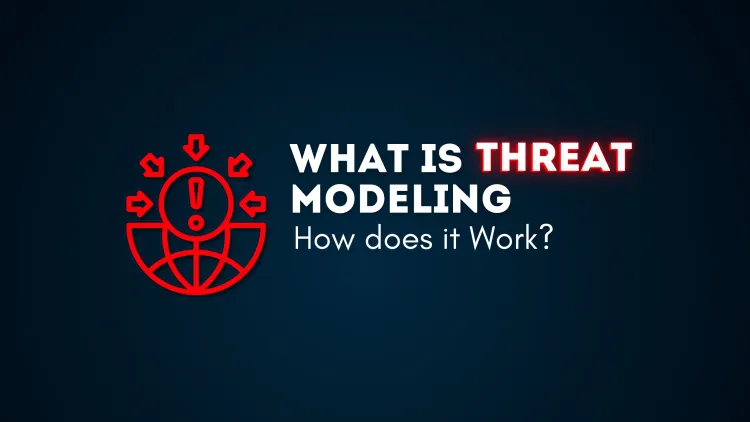What is Threat Modeling? How Does It Work?
Threat modeling is a crucial cybersecurity process aimed at identifying and mitigating potential risks to systems and data. By following structured methodologies like STRIDE and leveraging tools like OWASP Threat Dragon, organizations can proactively address vulnerabilities and strengthen their security defenses. Regular updates and collaboration among stakeholders ensure that threat modeling remains effective in countering evolving cyber threats.

In the realm of cybersecurity, threat modeling is a proactive approach used to identify, analyze, and mitigate potential security risks in applications, systems, or networks. By systematically evaluating possible threats, organizations can design more secure systems and reduce vulnerabilities before they become a target for cyberattacks.
What is Threat Modeling?
Threat modeling is a structured process that identifies potential security threats, assesses the risk associated with each, and implements measures to minimize or eliminate those risks. It provides a clear understanding of:
- Who might attack? (Threat actors)
- What might they target? (Assets)
- How might they attack? (Attack vectors)
This process helps organizations stay ahead of cyber threats, ensuring a robust defense mechanism for their systems.
Why is Threat Modeling Important?
Threat modeling is crucial for several reasons:
- Early Risk Detection: Identifies vulnerabilities during the design phase of a system or application.
- Cost Efficiency: Reduces the cost of fixing security issues later in the development lifecycle.
- Improved Security Posture: Enhances the overall security of systems by addressing potential threats proactively.
- Compliance: Ensures adherence to security standards and regulations.
How Does Threat Modeling Work?
The threat modeling process typically involves the following steps:
1. Identify Assets
Determine the critical assets (e.g., sensitive data, software, hardware) that need protection.
2. Define Security Objectives
Establish the security goals, such as protecting data confidentiality, integrity, and availability.
3. Identify Threats
Use tools like STRIDE or DREAD to categorize potential threats:
- STRIDE: Spoofing, Tampering, Repudiation, Information Disclosure, Denial of Service, Elevation of Privilege.
- DREAD: Damage potential, Reproducibility, Exploitability, Affected users, Discoverability.
4. Analyze Vulnerabilities
Assess the system for potential weaknesses that attackers might exploit.
5. Prioritize Threats
Rank threats based on their potential impact and likelihood, enabling teams to focus on the most critical issues.
6. Develop Mitigation Strategies
Implement measures like firewalls, encryption, secure coding practices, and regular patching to reduce or eliminate risks.
7. Continuously Review and Update
Threat modeling isn’t a one-time activity; it should be revisited periodically as systems evolve and new threats emerge.
Popular Threat Modeling Frameworks
Here are some commonly used frameworks for threat modeling:
- OWASP Threat Dragon: An open-source tool for visualizing and mitigating security risks.
- Microsoft Threat Modeling Tool: Focuses on identifying threats and suggesting mitigation techniques.
- PASTA (Process for Attack Simulation and Threat Analysis): A risk-centric framework that aligns security efforts with business objectives.
- TRIKE: A methodology that prioritizes threat analysis based on risk.
Benefits of Threat Modeling
- Enhanced Security: Identifies and addresses threats proactively.
- Resource Optimization: Focuses on the most critical vulnerabilities.
- Regulatory Compliance: Helps meet security standards like GDPR, ISO 27001, and HIPAA.
- Risk Reduction: Lowers the likelihood of successful attacks.
Best Practices for Effective Threat Modeling
- Involve Stakeholders: Collaborate with developers, security teams, and business leaders.
- Adopt a Framework: Use a standardized framework to ensure consistency.
- Integrate Early: Start threat modeling during the design phase of a project.
- Document Findings: Keep detailed records of identified threats, vulnerabilities, and mitigation strategies.
- Continuously Update: Reassess models as new threats and technologies emerge.
Conclusion
Threat modeling is an essential tool for building secure systems and safeguarding sensitive data. By systematically identifying and mitigating risks, organizations can enhance their cybersecurity posture, reduce vulnerabilities, and protect their assets from evolving threats. Whether you’re a security professional or a developer, incorporating threat modeling into your workflow is a critical step in ensuring a safer digital environment.
FAQs
-
What is threat modeling?
Threat modeling is a process used to identify, analyze, and mitigate security threats in a system. -
Why is threat modeling important?
It helps detect vulnerabilities early, reduces costs, and enhances the overall security of systems. -
What are the steps in threat modeling?
The steps include identifying assets, defining security objectives, identifying threats, analyzing vulnerabilities, prioritizing risks, and developing mitigation strategies. -
What frameworks are used in threat modeling?
Common frameworks include STRIDE, DREAD, OWASP Threat Dragon, and PASTA. -
When should threat modeling be conducted?
It’s best to perform threat modeling during the design phase and update it regularly. -
What tools are used for threat modeling?
Tools like Microsoft Threat Modeling Tool, OWASP Threat Dragon, and TRIKE are popular. -
How does STRIDE help in threat modeling?
STRIDE categorizes threats to help identify specific vulnerabilities in a system. -
What are the benefits of threat modeling?
It enhances security, optimizes resources, ensures compliance, and reduces risk. -
Who should be involved in threat modeling?
Developers, security teams, and business stakeholders should collaborate in the process. -
How often should threat modeling be updated?
It should be updated periodically, especially when systems or threat landscapes change.











![Top 10 Ethical Hackers in the World [2025]](https://www.webasha.com/blog/uploads/images/202408/image_100x75_66c2f983c207b.webp)



![[2025] Top 100+ VAPT Interview Questions and Answers](https://www.webasha.com/blog/uploads/images/image_100x75_6512b1e4b64f7.jpg)







